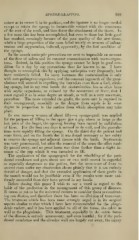Page 979 - My FlipBook
P. 979
SPONGE-GRAFTING. 989
extent as to secure it in its position, and the ligature is no longer needed
except to retain the sponge in immovable contact with the cenientum
of the root of the tooth, and thus favor the attachment of the tissue. In
a few cases this has been accomplished, but even in these but little good
has resulted, seemingly because of the poor quality of the nfew tissue,
while a large proportion of the cases failed utterly on account of inflam-
mation and suppuration, induced, apparently, by the foul condition of
the sponge.
In the mouth antiseptic precautions are next to impossible on account
of the flow of saliva and its constant contamination with micro-organ-
isnis. Indeed, in this position the sponge cannot be kept in good con-
dition for a day by any precautions thus far known to us. I have
thought to accomplish this by applying antiseptics very frequently, but
have uniformly failed. In many instances the contamination is only
with non-pathogenic organisms, and the constant ingrowth of the gran-
ulations will succeed in expelling the intruders even from a foul, stink-
ing sponge, but in my own hands the contamination has so often been
with septic organisms, as evinced by the occurrence of fever, that I
must regard it as in some degree an unsafe, as well as a very uncertain,
procedure. The more extended the grafts, the more care is required in
their management, especially as the danger from sepsis is in some
degree in proportion to the surface from which absorjstion may take
place.
In one case—a woman of about fitly—a sponge-graft was applied
for the purpose of filling in the upper jaw a gap about as large as the
last joint of the finger, the opening having been caused by exfoliation
of bone. For the first two days it seemed to do well, and the granula-
tions were rapidly filling the sponge. On the third day the patient had
some fever, and on the fourth day it was found necessary to her safety
to remove the sponge and adjacent tissues with the knife. Septicaemia
was very pronounced, but after the removal of the cause the effect read-
ily passed away, and no great harm was done farther than a slight in-
crease of the gap which it was intended to fill.
The application of the sponge-graft for the rebuilding of the peri-
dental membrane and gum about one or two teeth cannot be regarded
as especially dangerous to the patient, but the occurrence of fever in
several cases under my observation shows plainly that it is not entirely
devoid of danger, and that the extended application of these grafts in
the mouth would not be justifiable even if the results were more uni-
formly successful than they have proved in my hands.
Before closing this paper I wish to say a word in regard to the
habit of the profession in the management of this group of diseases.
It seems as yet to be the universal custom to consider them as constitut-
ing one disease, and therefore there has been no division of treatment.
The treatment which has been most strongly urged is in its surgical
aspects similar to that which I have here recommended for the phage-
denic variety, and it has been applied to all of the forms, the calcic as
well as the phagedenic. This treatment, especially in the calcic forms
of the disease, is entirely unnecessary, and even hurtful ; for if the peri-
dental membrane and the alveolar wall are largely cut away, the injury


